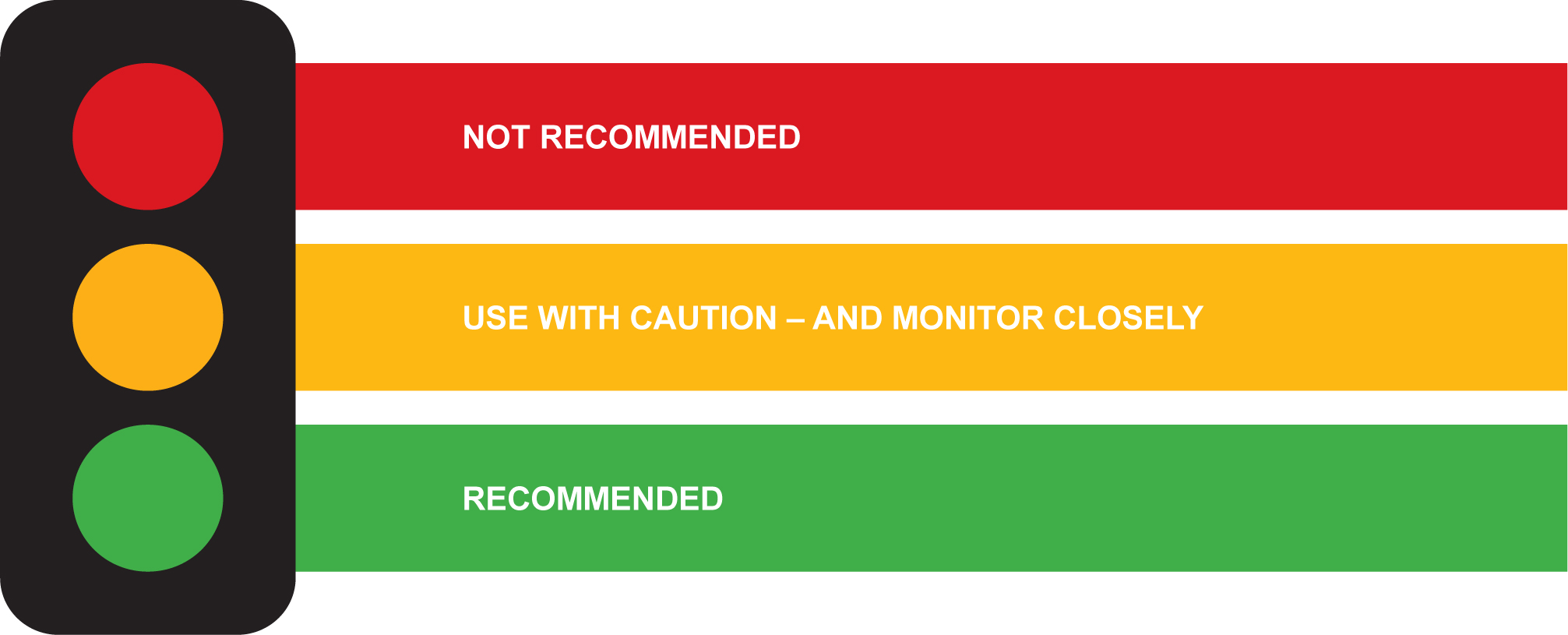Quick reference guide for the management of whiplash associated disorders (whiplash injury)
Follow these actions in the first 12 weeks after injury to provide the best possible management of adults with whiplash.
This quick reference guide summarises the recommendations of the guidelines for the management of acute whiplash-associated disorder for health professionals 2014. It is for healthcare professionals and the insurance industry. People with an acute whiplash injury may also find the information useful.
Traffic lights have been used to easily identify treatments that are recommended based on the strength of the clinical evidence and the consensus of clinical experts.

More information on the level of evidence is available in the Guidelines and technical report.
1. Do an examination
Conduct an examination to make a diagnosis and to direct treatment.
Recommended

Take a patient history including:
- circumstances of injury (for Canadian C-Spine Rule)
- presentation of symptoms
- prior history of neck problems
Do a physical examination:
- observe the patient's head position/posture
- palpate for tender points
- assess neck range of motion (ROM)
- conduct neurological testing
- assess any other injuries
- assess general health, including psychological state
Use the Canadian C-Spine Rule to determine if an X-ray is required for diagnosis of fracture or dislocation.
Classify the grade of whiplash to indicate the severity of injury. Use the Quebec Task Force (QTF) classification.
Not recommended

Do not use:
- MRI, CT, EEG, EMG, or specialised peripheral neurological test for WAD I and WAD II
- X-ray or CT except to diagnose fracture or dislocation. This is to avoid unnecessary exposure to X-rays
2. Identify people at risk of poor recovery
Outcome measures are the best way to identify people at risk of poor recovery.
Recommended

- assess pain using the Visual Analogue Scale (VAS)
- assess disability using the Neck Disability Index (NDI)
- assess expectations of recovery at the initial assessment by asking “Do you think you are going to get better soon?”
- assess psychological status using the Impact of Event Scale (IES) at 3-6 weeks
These factors can also predict poor recovery:
- decreased initial cervical range of motion (ROM)
- initial cold hyperalgesia (hypersensitivity to specific cold sensitivity testing)
Not recommended

Do not provide complex assessments, physical therapy referral or referral to a clinician with expertise in the management of whiplash to people at low risk of poor recovery:
- low disability (less than 15/50 for NDI)
- low pain (less than 5/10 for VAS)
- good expectations of recovery
Factors that do not predict poor recovery
The following factors do not predict risk of poor recovery:
- age, gender, marital status and education
- seat belt use, awareness of impending collision, position in vehicle and speed of collision
- pre-collision pain or general physical health status
- high healthcare utilisation for treatment of whiplash.
3. Provide treatment

Recommended treatment
These treatments are recommended for the best possible management of adults with whiplash.
![]()
Advise the person to stay active
Provide advice to continue usual activities as this will optimise recovery.
Provide advice that restricting or not doing usual activities because of the injury may cause delays in recovery.
Discuss daily activities and provide examples on how to modify, plan and simplify activities to reduce strain on the neck and to keep active.
Refer to the Recovering from whiplash page for examples of how to stay active.
![]()
Reassurance
Acknowledge that the person is injured and has symptoms. Advise that:
- symptoms are a normal reaction to being injured
- maintaining a normal life is important in the recovery process
- it is important to focus on improvements in function.
Encourage the injured person to take an active role in their recovery. As recovery progresses encourage self management and independence.

Neck exercises
Provide advice that neck exercises are effective in managing whiplash.
Recommend neck exercises such as range of motion, low load isometric, postural endurance and strengthening exercises.

First-line pain relief
Doctors should discuss strategies and medications for pain relief with the injured person.
Provide advice that regular paracetamol is the first option.
Non-Steroidal Anti-inflammatory Drugs (NSAIDs) may be used if regular paracetomol is ineffective.
Oral opioids, preferably short-acting agents at regular intervals, may be necessary to relieve severe pain. Any ongoing need for these drugs requires regular reassessment.

Use with caution - and monitor closely
Evidence for the following treatments is limited:
- manual therapy
- thoracic manipulation
- acupuncture
- trigger point needling
- kinesio taping
These physical treatments may be used in conjunction with the recommended treatments provided they are monitored closely and only continued if there is evidence of benefit (at least 10 per cent improvement on VAS and NDI at each review).

Not recommended
There is evidence that these treatments are not effective:
- reduction of usual activities for more than four days
- immobilisation collars
- pharmacology – anti-convulsants and anti-depressants
- muscle relaxants
- botulinum toxin type A
- intra-articular and intrathecal steroid injections
- pulsed electromagnetic treatment (PEMT)
These treatments should not be used.

Treatments with no evidence for or against their use
The following interventions may be applied for short periods, and in conjunction with other evidence based treatments provided there is continuing measurable improvement (at least 10 per cent improvement on VAS and NDI at each review).
- traction
- pilates
- feldenkrais
- alexander technique
- massage
- homeopathy
- cervical pillows
- magnetic necklaces
- spray and stretch
- heat
- ice
- transcutaneous electrical nerve stimulation (TENS)
- electrical stimulation
- ultrasound
- laser
- shortwave diathermy
4. Review and take recommended action
Use outcome measures to help to monitor progress and identify people at risk of poor recovery.
This is only a guide and there will always be individual differences.

Recommended
Below provides a summary of how to review patient progress, and what action to take based on the indicators of recovery or poor recovery during the first 12 weeks.
Use these assessments as part of the treatment program to monitor progress. If your initial assessment is more than seven days post-injury, use these intervals as a guide.
Initial assessment
Do these assessments:
| Indicates recovery | Recommended action |
|---|---|
|
|
| Indicates risk of poor recovery | Recommended action |
|---|---|
|
|
7 days post injury
Do these assessments:
| Indicates recovery | Recommended action |
|---|---|
|
|
| Indicates risk of poor recovery | Recommended action |
|---|---|
|
|
3 weeks post injury
Do these assessments:
Where the patient has unchanged VAS and NDI, do this assessment:
- Impact of Events Scale (IES) - screen for post traumatic stress
| Indicates recovery | Recommended action |
|---|---|
|
|
| Indicates risk of poor recovery | Recommended action |
|---|---|
|
|
6 weeks post injury
Do these assessments:
Where the patient has unchanged VAS and NDI scores, do this assessment:
- Impact of Events Scale (IES) - screen for post traumatic stress
| Indicates recovery | Recommended action |
|---|---|
|
|
| Indicates risk of poor recovery | Recommended action |
|---|---|
|
|
12 weeks post injury
Do these assessments:
| Indicates recovery | Recommended action |
|---|---|
|
|
| Indicates risk of poor recovery | Recommended action |
|---|---|
|
|
